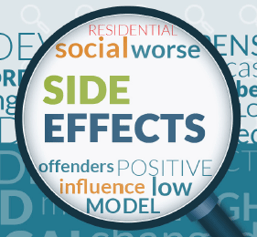This is the 5th of a 7 part series on The Risk Principle Simplified. Subscribe to our blog and get the series delivered right to your inbox.
Why would it make them worse?
All interventions have side effects. As some unfortunate cancer patients will attest, sometimes the cure is worse than the disease. Therefore, it is vital to consider the pros and cons of all interventions. Some of the down sides of residential placement for low risk offenders are as follows:
-
“The Social Learning Effect”: Low risk offenders tend to learn high risk behaviors and attitudes from high risk offenders. In practice, I have observed that high risk offenders tend to be stronger leaders, positive or negative, in group therapy sessions and residential environments. The well-intended idea of using low risk offenders as role models for high risk offenders is not likely to help the high risk clients, AND is likely to make the “role model” higher risk.
-
“The Ripple Effect”: When you place a low risk offender in residential, it has a ripple effect in the rest of their life. You take away their support system (that has, relatively speaking, been prosocial) and replace that social influence with a group of high risk offenders. Similarly, placing an offender in residential placement means that person will lose their job (if they have one), leaving them more time to observe, talk to, and imitate their residential cohorts, higher risk offenders.
- “The Double Trouble Effect”: When you label (verbally and/or socially) a person as someone who is abnormal enough that we must take them out of society (i.e., place them in residential), they tend to adopt that new identity. Furthermore, when the offender is discharged from residential placement two things happen:
- “The Scarlett Letter Effect”: Due to the stigma of being incarcerated, prosocial community members shun the offender returning home. Out of concern for their own safety and the potential impact on their children, they withdraw their social support. In other words, upon returning home, the offender is punished by the prosocial members of the community.
- “The New Tattoo Effect”: Returning home from incarceration is like getting a new tattoo. You have a new story to tell and other like-minded persons want to hear that story. Due to the distinction of “doing time”, high risk community members encourage the “war stories” and celebrate a rite of passage. In other words, upon returning home, the offender is positively reinforced by antisocial community members.
Lesson From Medicine
The medical industry has changed dramatically in the last three decades. Historically, when a medical professional determined that a patient needed a particular intervention, they prescribed it and the insurance company paid for it. These interventions often included very expensive hospital or inpatient stays. In the mid-1990s, the advent of Health Maintenance Organizations (HMO) arrived. Largely a response to the growing costs of medical care, HMOs no longer automatically paid for expensive treatment options. Leaning heavily on research, HMOs began challenging conventional wisdom about medical providers’ judgment and practices.
In the past, a 28-day stay in an inpatient substance abuse treatment program was the norm. However, after a review of the literature, HMOs determined that for most people, outpatient services, provided at a fraction of the cost, were just as effective. The same line of thinking was applied to every arena of medical care. Despite the ardent concerns of the public and medical associations, the change in medical intervention decision making gained momentum and changed medical practice in the U.S. dramatically. Procedures that formerly required several days in the hospital were now completed on any outpatient basis. In short, the new paradigm can be summed up as follows: Use the least expensive intervention that shows promise of addressing the problem.
An interesting discovery occurred during this transition. In many cases, a less expensive intervention produced better results than a higher level of care. Why? Guess who are in hospitals? Sick people. Guess what happens when you spent lots of time with sick people? You get sick. In many cases, it was discovered that the side effects of being in the hospital (e.g., sepsis infection), outweighed the benefits of the treatment. In other words, the treatment was worse than the illness. Alternatively, if you are really sick and avoid going to the hospital too long, it is likely that your health deteriorates.
In our next blog in this series, we will address "When High Risk is Too High". Subscribe to our blog and get the series delivered right to your inbox.



